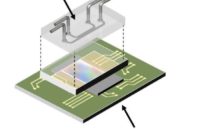Fluorescence microscopy gives researchers incredible power to illuminate the tiniest structures and capture the real-time activities of live cells by tagging biological molecules with a veritable rainbow of fluorescent dyes. This power comes at a cost: The technology can be expensive and time-consuming and, so far, has resisted attempts at automation. This situation may be changing however, with the introduction of microfluid chip-based platforms.
Researchers Develop A Rapid, Automatable, Chip-based Platform To Analyze Live Cells


 (585) 768-2513
(585) 768-2513
